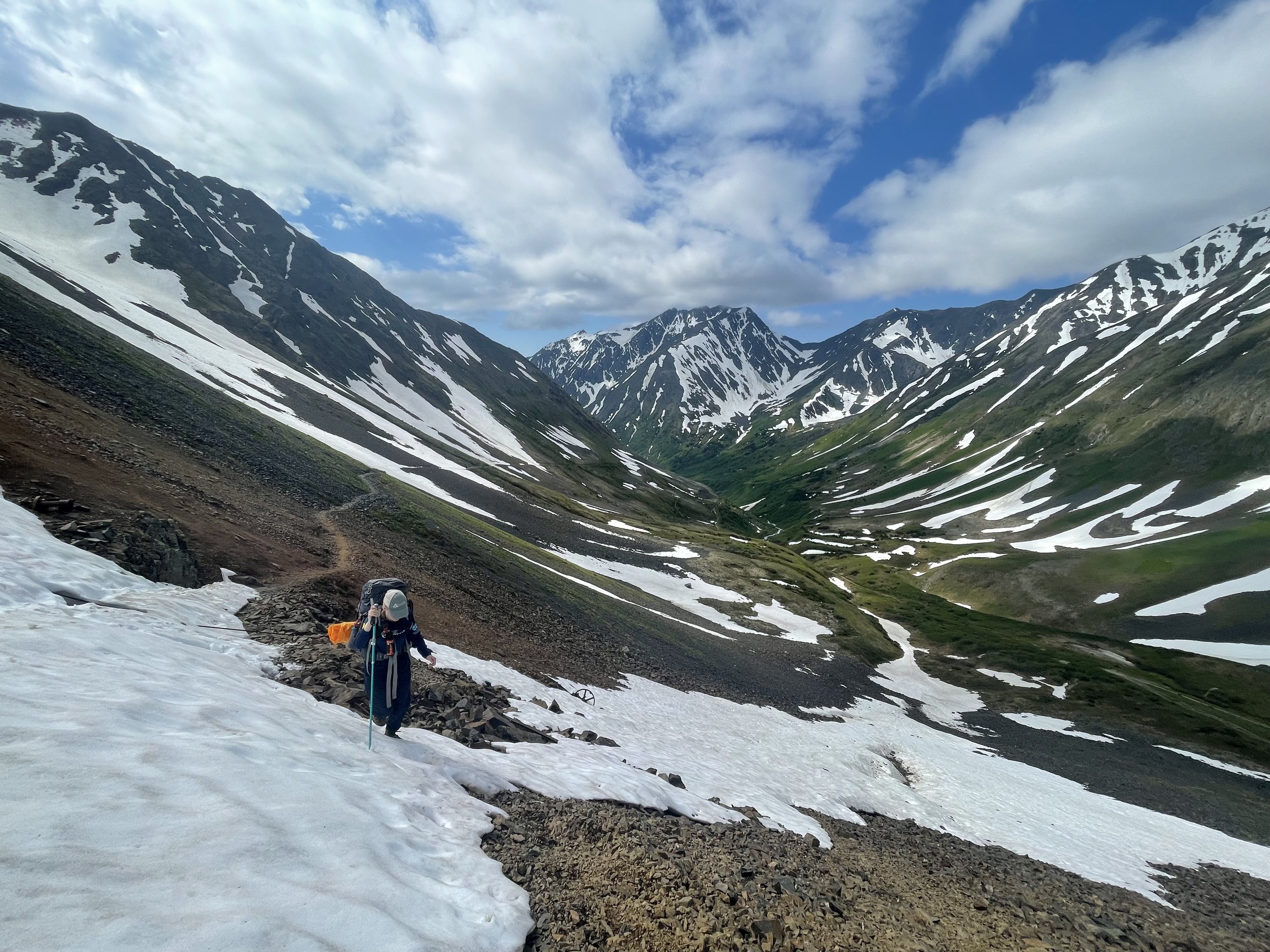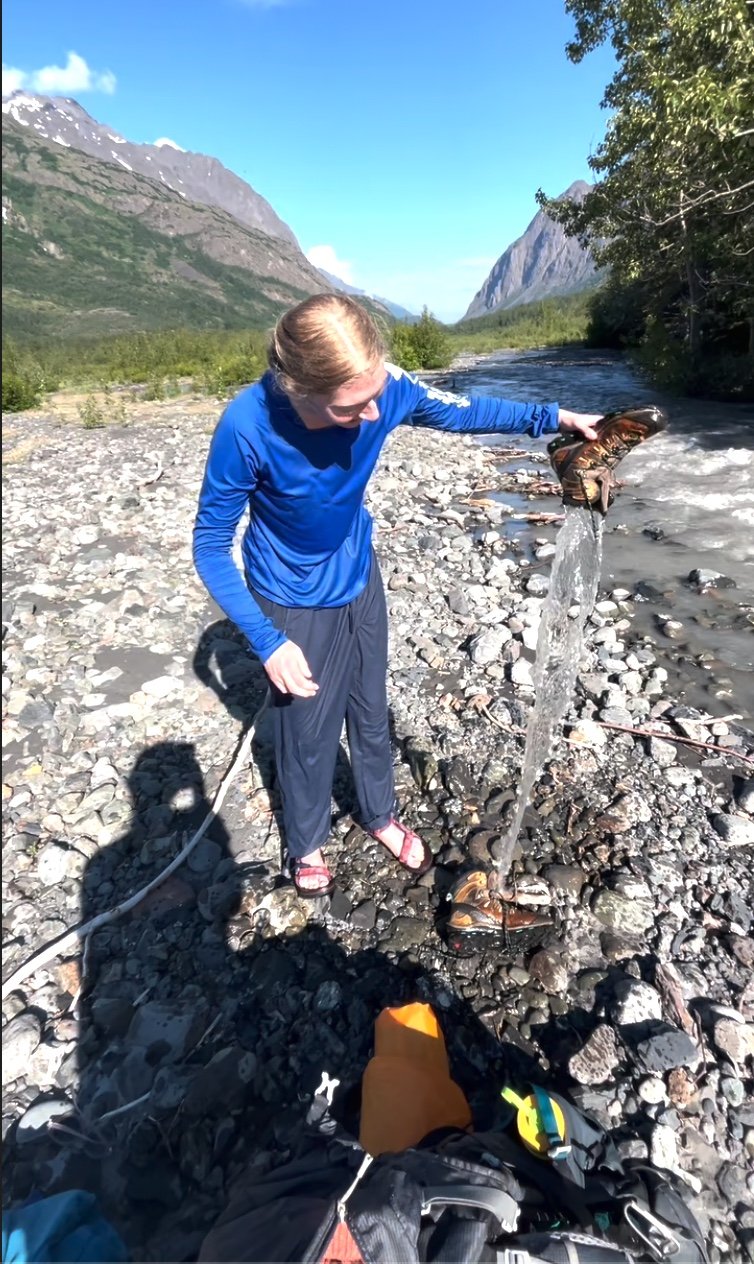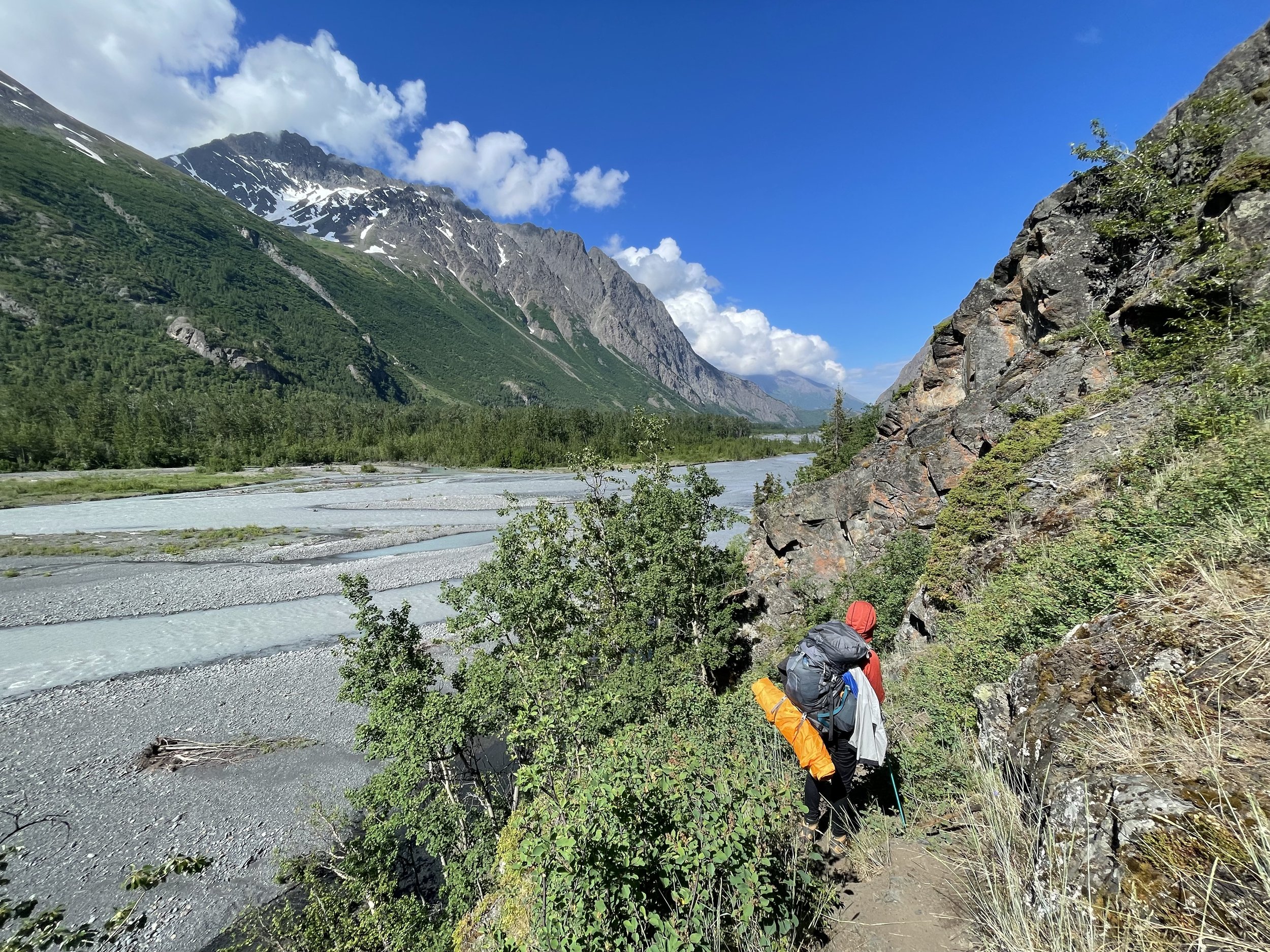Beyond the Handbook
At that moment, I realized I could drown, that maybe I was drowning.
Zoe Woods
Photo: Zoe Woods
Drowning is not how I thought I would die. If anything, I was more likely to fall off a mountain or get caught in an avalanche. I usually avoid water at all costs, but on Alaska’s Crow Pass Trail, there was no escaping it.
A few months earlier, I had finished my wilderness first responder certification (WFR) and was feeling ready to take on some serious backcountry. I loved the fast-paced scenarios and the trauma bonding with my classmates. When you take a WFR course, you’ll meet an entire cast of characters. My classmates included a woman preparing to climb Denali, a friendly doomsday prepper, and one guy we knew absolutely nothing about, except that he was ex-Mossad. We quickly broke the ice with an overdramatic improv. At first, these scenarios were benign—bruises, scratches, maybe an ankle that needed taping. But things got intense. One of our night sessions included a hypothermia drill in which a few volunteers got hosed down and sent outside to lie in the dirt. As we furiously tried to jam our muddy “hypothermic” patient into a sleeping bag, the instructors delighted in spraying us with squirt guns to simulate a rainstorm. Over five days, we must have experienced a full Grey’s Anatomy season of injuries (pro tip: the bruise makeup does not, in fact, wash out—you’ll have a black eye for days). The high pressure of these scenarios didn’t faze me; it did the opposite. When I took the written exam and completed the final field scenario, I was practically begging for a chance to use my skills in real life. Nature took note.
With my WFR sticker on my water bottle and a well-stocked first aid kit, my friend and I started out in late June with a plan to do the 23-mile hike in two days. For most places, late June is summer. In Alaska, June is barely spring. Even though rain is constant and snow is not unheard of, we got lucky with a stretch of two sunny days in a row. The weather was perfect; the glaciers were sparkling, and besides a few tricky snow patches, we were feeling good. Even reports of a river crossing at the halfway point couldn’t spoil our mood. But the sight of the river spooked us.
Eagle River was 200 feet across, waist-deep, rushing with the coldest, siltiest glacier water I’d ever seen. We’d paid the price for the gorgeous weather; the glacier was melting quickly, and water levels were higher than normal. The 35-degree water came to our upper thighs, and every step felt like being skewered by thousands of tiny needles. Bracing ourselves against each other, we made it to the other side and celebrated with freeze-dried Pad Thai.
The next morning, we continued to Thunder Gorge. It seemed innocuous, even though we couldn’t see through the milky water to assess the depth. We had crossed the granddaddy of river crossings the previous day, and this one was less than 10 feet across. But Thunder Gorge was rushing fast and deep. I went first. The first step was okay—cold for sure, but not higher than my knee. When I went to take my second step, the ground bottomed out beneath me and I was gone. The water was so cold I didn’t even feel it. When I opened my eyes, I was underwater. My first thought was, “Oh shit, my contacts.” Then, “My pack—I need to get my pack off.” But my arms were numb, and the force of the river held it in place. I was moving too fast to get my bearings, and the rocks on either side of me kept pushing my pack to one side, pinning me underwater. I was a pinball, hitting every rock and somehow not feeling any of them. Time slowed, and I remember feeling serene, not panicked at all—until I consciously realized I needed to roll over to breathe. At that moment, I realized I could drown, that maybe I was drowning.
I imagine I looked like a log rolling from one side to another, trying to stay above water. When I could get my head above water, my friend was sprinting along the bank, yelling and pointing at a bunch of roots on one side. I angled myself to intercept and desperately clung to one as the current tried to dislodge me. With the adrenaline rush of a mother lifting a car off her child, my friend pulled me and my soaking 75-pound backpack to shore. When I tried to stand, the weight of the pack and my disorientation nearly caused me to stumble back into the current. I don’t remember those first few moments, but my friend later told me I was speaking gibberish and shaking like a chihuahua. Of the two of us, I had wilderness first responder training. My friend had saved me from immediate danger, but it was up to me to figure out if I could walk out or if we needed to call for an evacuation.
I wish I could say I took deep breaths to clear my head and my training kicked in instinctively, but I forgot everything I’d learned. I certainly didn’t follow the step-by-step assessment I thought I had memorized. If I were a mock patient in the WFR class, I would be immediately approached by a friendly, trained passerby who would have spoken to me in a soothing voice while checking for life-threatening injuries and possible spinal injury. They would make a point of assessing my level of responsiveness for disorientation, alcohol or drugs, or shock.
On my own, I was fighting panic and adrenaline. I was hardly a reliable narrator of my responsiveness since I’d been speaking gibberish a few minutes earlier. I could only think in a single word. Breathing? Yes. Bleeding? No. Spine? Head? Good. My most pressing concern was the cold. Although I had probably only spent minutes in the water, I was in the danger zone and needed to get my body temperature up. The water had soaked through my bag, wetting and ruining all my clothes and sleeping bag. Thankfully, my friend scrounged up a few dry things. I ate a handful of trail mix while I shivered and tried to open my soggy first aid kit. Every single Band-Aid was wet and unusable; the Benadryl and Advil had started disintegrating. But I made a makeshift ankle wrap with an ACE bandage and took some ibuprofen. That would have to do. The best way to warm up was to keep moving.
There was no way out but through. I could stand and walk, albeit with a limp. Most of my injuries were superficial, and the adrenaline smoothed over most of the pain. Even so, the hike out was brutal. Over the next ten miles, the wet bag chafed and seemed to weigh more with every mile. My boots squelched with each step, and my feet sprouted blisters. What I thought would be a ten-mile walk along the valley floor turned out to be a fight against thick brush and washed-out trails. It included a section I later learned was aptly named “chutes and ladders.” When we finally reached the trailhead, we were just happy to come out in one piece. We celebrated the only way that felt appropriate, given our recent brush with danger—the biggest, greasiest burger we could find.
That backpacking trip taught me many things: How cold glacier water really is. That June might be too early for river crossings. How to be my own wilderness first responder. In a WFR class, you’ll learn plenty of strategies for leadership, teamwork, and communication. You’ll get to practice all kinds of scenarios with multiple rescuers and multiple patients. But you’ll never be performing an assessment and treatment on yourself—especially with the adrenaline, panic, and brain fog of a recent injury. Maybe most importantly, I came away understanding that no matter how much training you have, nature will find a way to test it.
Have a story or article idea to share?
Email us at covergroundusa@covergroundusa.com and include your title in the subject line. We’d love to hear from you.



